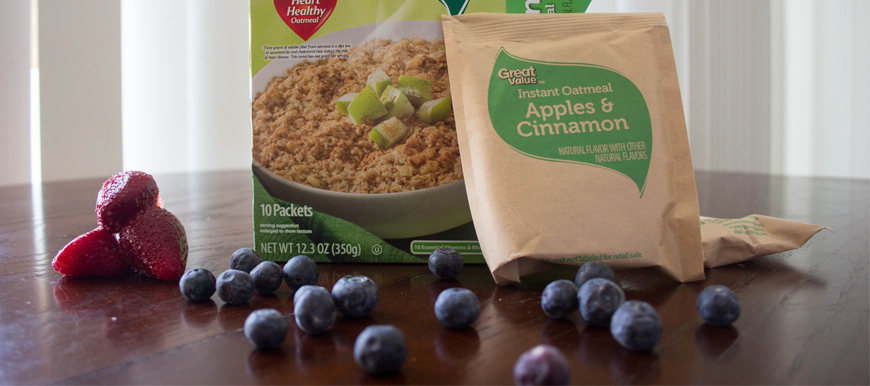Students find ways to eat healthy on tight budgets
Many college students experience shortages of time and money. But when it comes to eating healthy, there are ways to have your cake and eat it, too.
“One thing I think people could do is pack meals for themselves and kind of plan ahead, just be proactive about it,” said Cole Benson, a junior in psychology and exercise science. “Also getting up early and eating breakfast or making a lunch for yourself that day I think would help out.”
Planning out meals avoids needless spending on snacks, fast food and craving impulse buys. It also saves on prep time. If managed correctly, time and money — or the lack thereof — can work in favor of college students.
As associate nutrition professor at USU and mother of three, Heidi Wengreen said she relates to time constraints and budgets. Despite these challenges, she finds quick and easy ways to ensure she and her kids are eating well-balanced meals.
“Start with the basics and try to think of ways to try and make it healthier,” Wengreen said. “Instead of just having pasta and sauce, you can ask yourself, ‘What can I incorporate into this to make it a little bit healthier?’ So you might switch the pasta itself to whole grain instead of a refined grain pasta and then you can just add some vegetables to that sauce.”
The vegetables, she said, can even be frozen, which are more cost efficient and convenient.
Wengreen also suggested spicing up cheap, plain rice with vegetables and/or eggs, transforming it into a stir-fry dish. The same concept, she said, is also easily applicable to wraps. Starting out with a traditional chicken wrap, students can be creative when adding other ingredients.
“Always (be) reminding yourself to add a vegetable to that to make sure you’re getting a fruit and a vegetable with every single meal,” Wengreen said.
Xeenea Tribe, an undeclared allied health freshman, found an aid in her eat-well endeavors.
“My roommates and I cook dinners together so it’s super nice. We go out for maybe lunch or breakfast, but we always make dinner, and it’s usually pretty healthy,” Tribe said.
She found that cooking for herself is a challenge, so cooking with others has been a positive alternative.
“I like to plan meals ahead of time and have support. I can turn to my roommate and be like ‘What are we going to make?’ And then we put stuff together and make something,” she said.
For a healthy snack, Tribe also enjoys munching on cucumbers, especially at night. But in the winter months, higher priced vegetables and fruits that aren’t so scrumptious can be a deterrent for many students.
According to Wengreen, canned foods can be a great alternative to fresh produce when money is tight or when fruits and vegetables are not in season.
“Sometimes you do have to pay a little more for the fresh and local options, but you just have to balance that out. It’s always better to eat it than to not to eat it, even if it’s canned,” she said.
Canned goods, Raman Noodles, macaroni and cheese and other low-priced boxed and packaged foods are popular buys for college students. Though convenient, these simple food choices are more than just loaded carbohydrates. Wengreen warned students to be wary about the sodium and sugar content found in canned and processed foods.
According to the American Heart Association, the daily recommendation for sugar intake is six teaspoons for women and nine teaspoons for men. The average can of soda contains eight to nine teaspoons of sugar.
Added sugar means added calories, Wengreen said, which contributes to weight gain.
“They’ve found that with the overconsumption of added sugars, there is an increasing risk of cardiovascular disease, risk for high blood pressure and other related diseases such as type II diabetes,” Wengreen said. “So even if you don’t struggle with your weight, you need to be cutting out that added sugar.”
The trick, she said, is to replace the sugar with things you need: fruits, vegetables and whole grains.
Aside from the aforementioned goods, protein is another necessary nutrient. It is also the priciest, at least when it comes down to meats. Students with empty pockets sometimes struggle to get a solid amount of protein without breaking the bank. However, beans are one solution.
“Legumes are a great source of protein and they are super, super cheap,” Wengreen said. “Plus, you can add them to anything. Just start cooking with your base, such as rice or pasta, and keep adding to it until it’s a balanced meal.”
Eating healthy while cutting back to save money and calories is no easy task, and for some it may feel more like a punishment than a benefit. However, when balanced properly, healthy and cost effective eating can be rewarding.
“Food is to be enjoyed. It’s not just for the nutrients it provides,” Wengreen said. “Nobody should feel like they have to cut out any one food. It really can all fit. It’s just the way we put it together in our whole meal, whole day and whole pattern of eating.”
— ariell.allred@aggiemail.usu.edu

